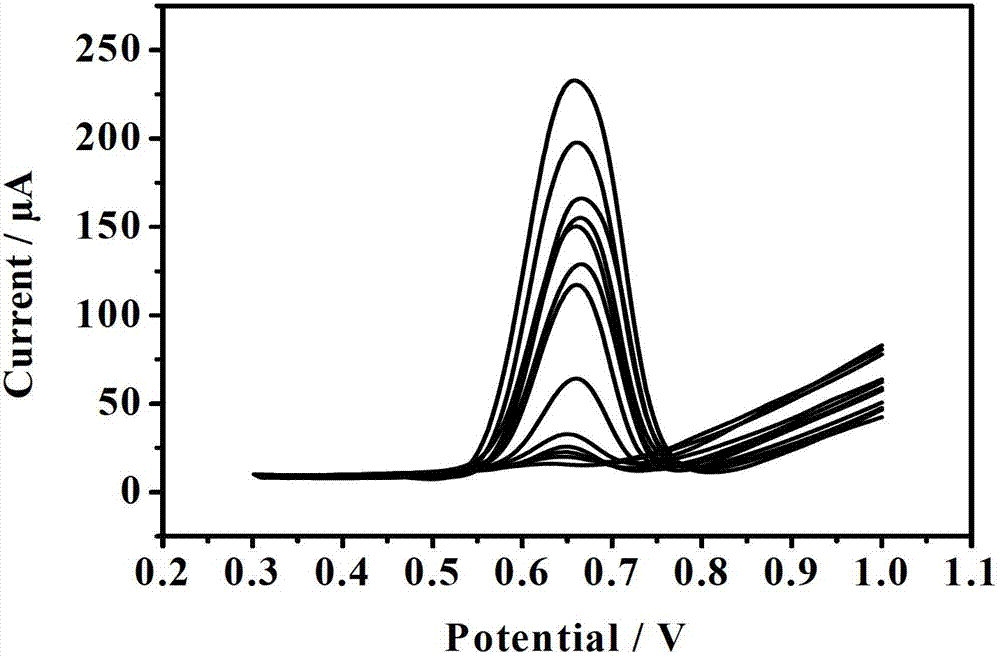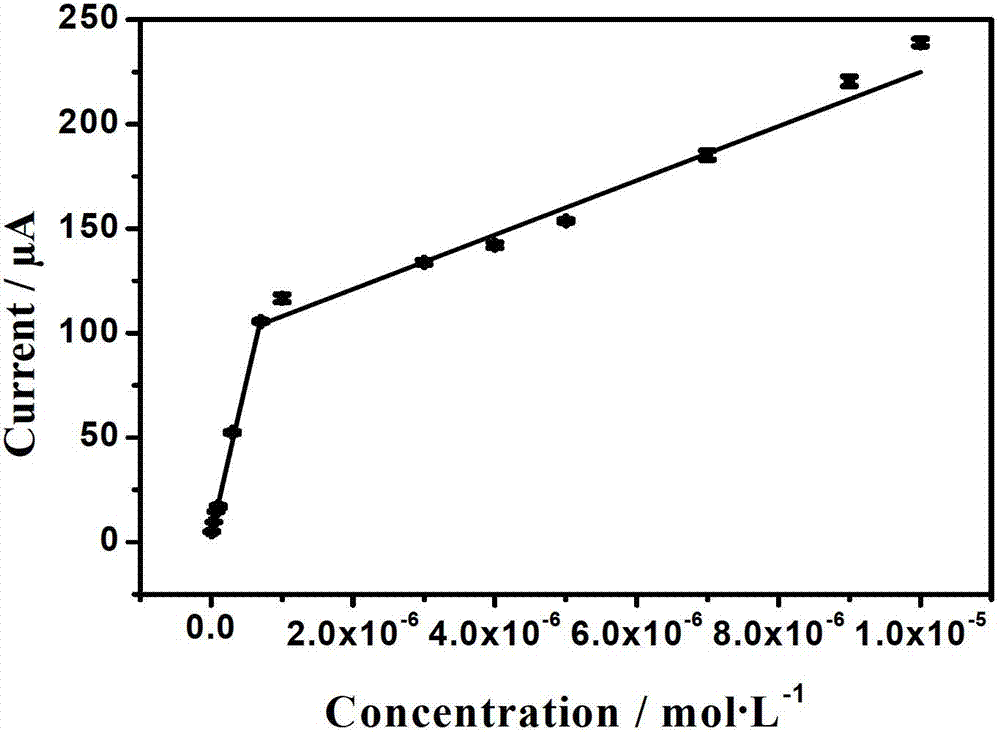Method for detecting prohibited additive acid orange II in food
An acid orange and additive technology, which is applied in the field of quantitative detection of banned additives in food, acid orange II, can solve the problems of high cost and harsh experimental operating conditions.
- Summary
- Abstract
- Description
- Claims
- Application Information
AI Technical Summary
Problems solved by technology
Method used
Image
Examples
Embodiment 1
[0026] (1) Preparation of expanded graphite electrodes:
[0027] Put the expanded graphite prepared by chemical oxidation method and solid paraffin in a beaker with a mass ratio of 99:1, stir continuously to mix the two evenly, heat slightly until the paraffin is completely melted, and after cooling to room temperature, fill the above mixture into the electrode, Then the surface of the expanded graphite electrode is polished and rinsed with deionized water for subsequent use;
[0028] (2) Draw the standard curve:
[0029] Set the concentration to 1.0 x 10 -8 mol L -1 , 4.0×10 -8 mol L -1 , 7.0×10 -8 mol L -1 , 1.0×10 -7 mol L -1 , 3.0×10 -7 mol L -1 , 7.0×10 -7 mol L -1 , 1.0×10 -6 mol L -1 , 3.0×10 -6 mol L -1 , 4.0×10 -6 mol L -1 , 5.0×10 -6 mol L -1 , 7.0×10 -6 mol L -1 , 9.0×10 -6 mol L -1 and 1.0×10 -5mol L -1 Take 20mL of the standard stock solution in a beaker, insert the electrode obtained in step (1), and after 9 minutes of open-circuit enric...
Embodiment 2
[0037] Sample source: bean curd skin sold in a supermarket
[0038] Weigh 5.0 g of a commercially available bean curd skin sample into a 100 mL beaker, add 50 mL of ethanol solution, and ultrasonically extract at room temperature for 30 min. Centrifuge at 5000rpm for 10min, collect the supernatant, and dilute to 100mL with ethanol solution. Take 2.0mL of the sample solution to be tested after extraction, in 0.1mol L of pH5.5 -1 In the supporting electrolyte of BR buffer solution, the electrochemical test was carried out according to the method and steps of Example 1, and the concentration of Acid Orange II in the tested sample was calculated according to the current value obtained by scanning and the linear regression equation corresponding to the standard curve. The measurement results show that the measured oxidation peak current value is zero, that is, the tested sample does not contain the prohibited food additive Acid Orange II. In the above sample solution to be tested...
Embodiment 3
[0042] Sample source: a brand of fresh fruit orange
[0043] Pipette 10.0 mL of fresh fruit orange into a 100 mL beaker and filter through a 0.45 μm filter membrane. Centrifuge at 5000rpm for 10min, collect the supernatant, and dilute to 100mL with deionized water. Take 2.0mL of the sample solution to be tested after extraction, in 0.1mol L of pH5.5 -1 In the supporting electrolyte of BR buffer solution, the electrochemical test was carried out according to the method and steps of Example 1, and the concentration of Acid Orange II in the tested sample was calculated according to the current value obtained by scanning and the linear regression equation corresponding to the standard curve. The measurement results show that the measured oxidation peak current value is zero, that is, the tested sample does not contain the prohibited food additive Acid Orange II. In the above sample solution to be tested, add 1.0mL of 1.0×10 -4 mol L -1 Acid Orange II standard solution, so that...
PUM
| Property | Measurement | Unit |
|---|---|---|
| Sensitivity | aaaaa | aaaaa |
Abstract
Description
Claims
Application Information
 Login to View More
Login to View More - R&D
- Intellectual Property
- Life Sciences
- Materials
- Tech Scout
- Unparalleled Data Quality
- Higher Quality Content
- 60% Fewer Hallucinations
Browse by: Latest US Patents, China's latest patents, Technical Efficacy Thesaurus, Application Domain, Technology Topic, Popular Technical Reports.
© 2025 PatSnap. All rights reserved.Legal|Privacy policy|Modern Slavery Act Transparency Statement|Sitemap|About US| Contact US: help@patsnap.com



